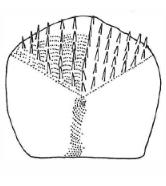ソコダラ科
- HOME
- デジタル図鑑
- パタゴニア海域の重要水族
- 硬骨魚綱 タラ目
- ソコダラ科
ソコダラ科(Macrouridae)

42 チリコソコダラ(Chiri-kosokodara)
Macruroplus potronus Pequeno, 1971
特 徴:
背鰭2棘,10〜11軟条 約120軟条,臀鰭 約110軟条,胸鰭12〜22軟条,腹鰭13〜15軟条,鰓耙数11〜13。頭長は臀鰭前長の60.2〜74.3%,骨質眼窩径は22.5〜26.7%,体高は65.1〜68.6%,吻長は14.7〜18.3%,両眼間隔は11.1〜14.2%,上顎長は25.2〜30.5%,第1背鰭高は71.1〜78.9%,胸鰭長は38.5〜50.7%,腹鰭長は24.4〜29.6%。体は側扁し延長し,亜円筒形ではなく,尾部は糸状に伸長する。背鰭起部における体高は体幅より著しく小。
吻は非常に短く,吻長は眼寓径より短い。眼は著しく大きく,体長は眼径の約2.5倍。両眼間隔域は平坦で,その幅は眼寓径の約半分。下顎先端に小さな髭があり,その長きは眼径より小。口は下位で伸出可能。両顎に小歯帯が発達し,上顎ではその外側歯は内側歯より大きい。鋤骨と口蓋骨は無歯。擬鯉はない。短い鰐津Eが発達する。頭部と体部に櫛鱗が分布する。各櫛鱗は後方を向く7〜15列の小糠を備える。第l背鰭は高〈,前縁上方に黒点があり,第2腕前縁は鋸歯状を呈す。第2背鰭は低〈基底は長〈,その起部は旺門の上に位置する。胸鰭は中庸で,その起部は腹鰭起部上にある。腹鰭は胸鰭より短〈,その外側鰭条は内側鰭条より長い。脅鰭は第2背鰭より基底が長い。側線は単線で,第2背鰭起部下で急に下降する。旺門の周囲に発光器がある。肛門は腹鰭先端と腹鰭起部の中間に位置する。胸鰭基底部付近と偲条膜は無鱗で真黒色を帯びる。
分 布:
チリ パタゴニア。
備 考:
チリ海域では,Macruroplus属にはMacruroplus属には,M.potronus, M.pudens,M.pulchellusの3種が記録されている(Bahamondeand
Pequeno, 1975) 。 (中村 泉)
Material examined:
10 from Chile (219.0-301.4 mm TL), FAKU S 556,557; CP 551 556,890, 891.
Description:
D II, 10-11, ca. 120; A ca. 110; P1 19-22; P2 13-15; GR 11-13. HL 60.2-74.3% of PreA; BO 22.5-26.7; BD 65.1-68.6; SN 14.7-18.3; IO 11.1- 14.2; UJ 25.2-30.5; DH1 71.1- 78.9; P1 L 38.5-50.7; P2 L 24.4- 29.6.
Body compressed, elongate, not subcylindrical, with tapering tail. Width at dorsal origin much smaller than depth. Head large, about 1.6 times in preanal length. Snout very short and slightly anterior to mouth, its length shorter than orbit diameter. Eye very large about 2.5 times in HL. Interorbital region flat, its length about half of orbit diameter. A small barbel on chin, its length less than eye diameter. Mouth inferior and protractile. A small tooth band on both jaws, outer row enlarged on upper jaw. No teeth on vomer or palatines. No pseudobranchiae. Gill-rakers fairly well developed, short. Very small ctenoid scales all over head and body, each with small spines in 7-15 rows, directed backward. First dorsal fin high with a dark blotch on anterodistal part, anterior margin of 2nd spine with fine serrations. First dorsal fin origin above anus, first spine with serrations on anterior margin. Pectoral fin moderate, its origin above pelvic fin origin. Pelvic fin with about 14 rays, outer ray filamentous. Anal fin higher than 2nd dorsal fin. Single lateral line running from upper insertion of opercle to caudal fin base, curving abruptly downward below region of 2nd dorsal fin origin. A luminescent organ present around anus. Anus situated between posterior end of pelvic fin base and anal fin origin. Around pectoral fin base and branchiostegal membrane naked and tinged with jet black.
Distribution:
Chilean Patagonia.
Remarks:
Three species of Macruroρ加, M. ρotronus, M. ρudens (Gilbert et Thompson,
1916), and M. ρulchell附 Pequeno, 1971, are known in Chilean waters (Bahamonde
and Pequeno, 1975).

Distribution of Macruroplus potronus in Patagonia.

Scale below lateral line.